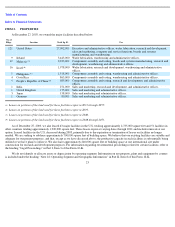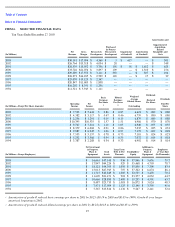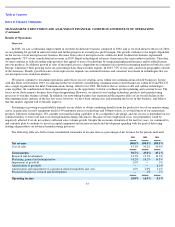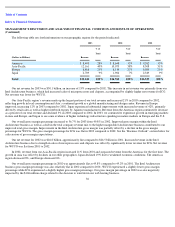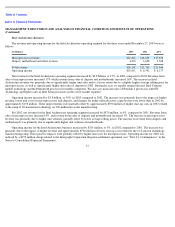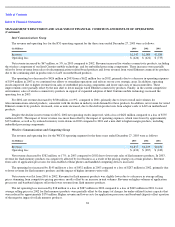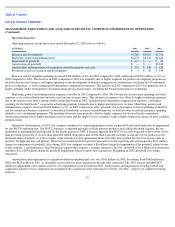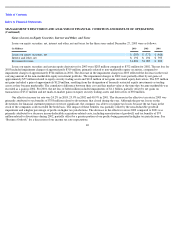Intel 2003 Annual Report Download - page 33
Download and view the complete annual report
Please find page 33 of the 2003 Intel annual report below. You can navigate through the pages in the report by either clicking on the pages listed below, or by using the keyword search tool below to find specific information within the annual report.
Table of Contents
Index to Financial Statements
MANAGEMENT’S DISCUSSION AND ANALYSIS OF FINANCIAL CONDITION AND RESULTS OF OPERATIONS
(Continued)
Intel Architecture Business
The Intel Architecture business supports the desktop, mobile and enterprise computing platforms. As devices take advantage of
converged computing and communications capabilities, our goal is to continue to deliver processors with higher performance and/or advanced
technology features such as HT Technology, which can enable multithreading and multitasking, and the features offered with our Intel
®
Centrino
™
mobile technology, which can enhance the mobile computing experience. In addition, we believe that system security and reliability
features at the hardware level will facilitate an enhanced computing experience for end users.
For the desktop platform, our strategy is to introduce microprocessors and chipsets with higher performance and/or advanced technology
features tailored to the needs of different market segments using a tiered branding approach. For the mobile platform, our strategy is to deliver
products optimized for some or all of the four mobility vectors: performance, battery life, form factor (the physical size and shape of a device)
and wireless connectivity. Our strategy for the enterprise platform is to provide processors and chipsets with high performance and/or advanced
technology features, as well as competitive price for performance for entry-level to high-end servers and workstations.
For the desktop performance market segment, we offer the Intel
®
Pentium
®
4 processor to meet the computing needs of users both at
home and at work. These processors are optimized to deliver high performance as well as added features across a broad range of business and
consumer applications. For the performance desktop, we offer the Pentium
®
4 processor with HT Technology. When used in a computer
system with the other features required to take advantage of this technology, HT Technology allows a multithreaded software program to run as
though it uses two processors, even though it uses only one processor. Our current versions of the Pentium 4 processor with HT Technology
support the 800-MHz system bus, which allows for faster data transfer into and out of the processor. For the desktop value market segment, we
offer the Intel
®
Celeron
®
processor, designed to meet the core computing needs and affordability requirements of value-conscious PC users.
For the mobile market segment, we offer processors optimized for performance mobility and portability users, with form factors from
sub-notebook and tablet PCs to thin-and-light and full-size notebook PCs. In 2003, for performance mobility users, we introduced Intel
Centrino mobile technology, our first computing technology designed and optimized specifically for the four key vectors of mobility. Intel
Centrino mobile technology consists of an Intel
®
Pentium
®
M processor and the Intel
®
855 chipset family, both offered by the Mobile
Platforms Group within the Intel Architecture business, as well as a wireless network connection, which is based on the 802.11 industry
standard, from ICG. For portability PC users—who want systems with near-desktop features, including high performance, larger screens, full-
size keyboards and multiple hard drives—we offer the Mobile Intel
®
Pentium
®
4 processor. In addition, for the mobile value market segment,
we offer the mobile Intel Celeron processor.
The Intel Architecture business also supports the enterprise platform by offering products that address various levels of data processing
and compute-intensive applications. Our Intel
®
Xeon
™
processor family of products supports a range of entry-level to high-end technical and
commercial computing applications for the workstation and server market segments, while our Intel
®
Itanium
®
processor family of products
supports an even higher level of computing performance for data processing, the handling of high transaction volumes and other compute-
intensive applications for enterprise-class servers, as well as supercomputing solutions. The Intel
®
Xeon
™
processor with HT Technology is
aimed at two-way servers, also known as dual-processing (DP) servers, and workstations. For servers based on four or more processors, we
offer the Intel
®
Xeon
™
processor MP with HT Technology. For the enterprise-class market segment, we offer the Intel
®
Itanium
®
2 processor.
We believe that technology industry product developments and the convergence of computing and communications will increase demand for
our higher performance enterprise platform products. In particular, we anticipate increased demand for our products to support new
developments in data traffic management, storage, and wireless computing and communications needs.
Intel Communications Group
Within ICG, our strategy is to be the leading supplier of silicon and integrated networking and communications building blocks for
original equipment manufacturers (OEMs) and other systems builders. We are developing products that we believe will help to build out the
Internet: products designed for wired and wireless connectivity; the communications infrastructure, including network and embedded
processors; and networked storage. Our strategy for Ethernet connectivity is to expand our product portfolio in the local area network (LAN)
market segment and to address the metropolitan area network (MAN) and networked storage market segments. Within the LAN and MAN
market segments, we are investing in Gigabit Ethernet, 10-Gigabit Ethernet and wireless technologies based on
30





